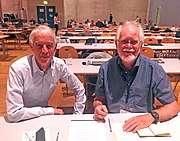Jacques Dubochet
Jacques Dubochet (born 8 June 1942)[1] is a retired Swiss biophysicist.[2][3] He is a former researcher at the European Molecular Biology Laboratory in Heidelberg, Germany, and an honorary professor of biophysics at the University of Lausanne in Switzerland.[3][4]
Jacques Dubochet | |
|---|---|
.jpg) Jacques Dubochet in 2017. | |
| Born | 8 June 1942 |
| Citizenship | Switzerland |
| Education | École polytechnique fédérale de Lausanne (BS) University of Geneva (MS) University of Geneva (PhD) University of Basel (PhD) |
| Known for | Cryo-electron microscopy |
| Awards | Nobel Prize in Chemistry (2017) |
| Scientific career | |
| Fields | Structural biology Cryo-electron microscopy |
| Institutions | European Molecular Biology Laboratory (1978-1987) University of Lausanne (since 1987) |
| Thesis | Contribution to the use of dark-field electron microscopy in biology (1974) |
| Doctoral advisor | Eduard Kellenberger |
In 2017, he received the Nobel Prize in Chemistry together with Joachim Frank and Richard Henderson "for developing cryo-electron microscopy for the high-resolution structure determination of biomolecules in solution".[5][6]
Career
Dubochet started to study physics at the École polytechnique de l'Université de Lausanne (now École polytechnique fédérale de Lausanne) in 1962 and obtained his degree in physical engineering in 1967.[4] He obtained a Certificate of Molecular Biology at University of Geneva in 1969 and then began to study electron microscopy of DNA. In 1973, he completed his thesis in biophysics at University of Geneva and University of Basel.[7]
From 1978 to 1987, Jacques Dubochet was group leader at the European Molecular Biology Laboratory in Heidelberg, then part of West Germany.[4] From 1987 to 2007, he was professor at the University of Lausanne.[4] In 2007, at 65 years old, he retired and became an honorary professor at the University of Lausanne.[4]
During his career, Jacques Dubochet developed technologies in cryo-electron microscopy, cryo-electron tomography and cryo-electron microscopy of vitreous sections.[8][9][10][11] These technologies are used to image individual biological structures such as protein complexes or virus particles.[3] At Lausanne he took part in initiatives to make scientists more aware of social issues.[12][13]
In 2014, Jacques Dubochet received EMBL's Lennart Philipson Award.[8] Describing his career in 2015, Professor Gareth Griffiths, his colleague at EMBL explained: "Jacques had a vision. He found a way of freezing thin films of water so fast that crystals had no time to form [that could damage samples] [...] over time the technique has become increasingly important to life science research, and it is clear today it is Nobel Prize-worthy."[3]
.jpg) Jacques Dubochet at the Nobel Prize press conference in Stockholm (December 2017).
Jacques Dubochet at the Nobel Prize press conference in Stockholm (December 2017). Jacques Dubochet and EPFL President Martin Vetterli at the Scientific and Educational Days 2018.
Jacques Dubochet and EPFL President Martin Vetterli at the Scientific and Educational Days 2018.
When asked by his university how he would like his Nobel Prize to be recognised by the institution he asked for a parking space for his bicycle which was duly given. He had cycled to his lab almost every day for 30 years.[14]
Personal life
Jacques Dubochet is married with two children.[7] He has dyslexia.[7]
In the 1970s, for the second meeting with his future wife, they went to protest against the Kaiseraugst nuclear power plant construction project.[15]
Dubochet is a member of the Social Democratic Party of Switzerland, and a member of the municipal parliament of Morges, where he holds a seat on the supervisory committee.[16][17]
Bibliography
- (in French) Jacques Dubochet, Parcours, Éditions Rosso, 2018, 216 pages (ISBN 9782940560097).
Notes and references
- "Members' Directory - EMBL". www.embl.it. European Molecular Biology Laboratory. Retrieved 4 October 2017.
- Dubochet, Jacques (February 2016). "A Reminiscence about Early Times of Vitreous Water in Electron Cryomicroscopy". Biophysical Journal. 110 (4): 756–757. Bibcode:2016BpJ...110..756D. doi:10.1016/j.bpj.2015.07.049. PMC 4775787. PMID 26362521.
- Wilson, Rosemary; Gristwood, Alan. "Science, society & serendipity". European Molecular Biology Laboratory. Retrieved 4 October 2017.
- "Nouveaux professeurs honoraires 2007" [New Honorary Professors] (PDF) (in French). University of Lausanne. p. 13. Archived from the original (PDF) on 5 October 2017. Retrieved 4 October 2017.
- "The 2017 Nobel Prize in Chemistry - Press Release". www.nobelprize.org. 4 October 2017. Retrieved 4 October 2017.
- "Nobel Prize in Chemistry Awarded for Cryo-Electron Microscopy". The New York Times. 4 October 2017. Retrieved 4 October 2017.
- "Prof. Jacques Dubochet - Honorary Professor of biophysics [curriculum vitae]". University of Lausanne. Archived from the original on 4 October 2017. Retrieved 4 October 2017.
- "Alumni awards". EMBL. Retrieved 4 October 2017.
- Dubochet, J.; Lepault, J.; Freeman, R.; Berriman, J. A.; Homo, J.-C. (December 1982). "Electron microscopy of frozen water and aqueous solutions". Journal of Microscopy. 128 (3): 219–237. doi:10.1111/j.1365-2818.1982.tb04625.x.
- Dubochet, J.; McDowall, A. W. (December 1981). "Vitrification of pure water for electron microscopy". Journal of Microscopy. 124 (3): 3–4. doi:10.1111/j.1365-2818.1981.tb02483.x.
- Dubochet, Jacques (March 2012). "Cryo-EM-the first thirty years". Journal of Microscopy. 245 (3): 221–224. doi:10.1111/j.1365-2818.2011.03569.x. PMID 22457877.
- Dubochet, Jacques (January 2008). "Citizen biologists. The Lausanne experience". EMBO Reports. 9 (1): 5–9. doi:10.1038/sj.embor.7401146. PMC 2246622. PMID 18174891.
- Dubochet, Jacques (April 2003). "Teaching scientists to be citizens". EMBO Reports. 4 (4): 330–332. doi:10.1038/sj.embor.embor810. PMC 1319166. PMID 12671671.
- https://twitter.com/CycleLuxembourg/status/1184086167526006789?s=20
- (in French) Muriel Raemy, "J'ai toujours voulu comprendre le monde", Moneta, journal of the Alternative Bank Switzerland, number 2 of year 2018, pages 21-22.
- "Jacques Dubochet, le savant atypique". Le Temps (in French). 4 October 2017. Retrieved 4 October 2017.
- "Le CV tout en humour du prix Nobel vaudois Jacques Dubochet" [The humorous CV of the Waldensian Nobel Prize Jacques Dubochet] (in French). Radio Télévision Suisse. 4 October 2017. Retrieved 4 October 2017.
External links
| Wikiquote has quotations related to: Jacques Dubochet |
- Official page
- (in French) Blog
- Jacques Dubochet on Nobelprize.org including the Nobel Lecture on 8 December 2017 Early cryo-electron microscopy
